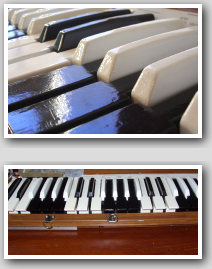
|
|
|
Balanced
keyboard layout
The dimensions and overall feel of the Balanced keyboard are similar to the standard keyboard. However, the keys are
now in a regular and
consistent layout. The following pictures show 3 octaves of the standard
keyboard and 3 octaves of the Balanced keyboard for comparison:
| Standard
keyboard (3 octaves) |
|
|
| Balanced
keyboard (3 octaves) |
|
|
As you can see, the Balanced keyboard mixes up the black and white keys
in both the top and bottom rows. The black and white colours
still correspond to the natural (white) or sharp/flat (black) notes as
on the standard keyboard, making the Balanced keyboard straightforward
to navigate.
Alternative Balanced keyboard layout
(F-based)
The C-based Balanced keyboard layout shown above is historically the most common arrangement of
the Balanced keyboard, and has the white keys of C, D and
E in the bottom row. However, there is also an alternative F-based layout, which
has the white keys of F, G, A and B in the bottom row:
| F-based Balanced
keyboard (3 octaves) |
|
|
This layout was kindly suggested to this website by Doug Keislar, the
current editor of the Computer Music Journal, who modified a piano to this
layout back in in 1980! Doug suggested that this layout has the
advantage of having 7 keys in the same position as the standard keyboard. By
comparison, the C-based layout
has only 5 keys in the same position, but it might be more familiar if you normally
navigate from C.
Note layout
The note-by-note layout of 1 octave of the C-based Balanced keyboard is as
follows:
| Balanced
keyboard note layout (1 octave) |
|
|
Physical dimensions
The main dimensional difference of the Balanced keyboard is in the
bottom-row keys. The Balanced keyboard has six bottom-row keys per
octave instead of the standard keyboard's seven. Because these keys occupy
the same physical octave width as on the standard keyboard, the
Balanced keyboard has a wider bottom-row key spacing. For a Balanced
keyboard created by modifying a standard keyboard (as described in the
Build one section of this website), this means that
the bottom-row keys will have small gaps between them.
However, in the top row, both the key widths and the spacings of the keys are still
the same, so there is still a similar feel to the standard
keyboard, and you can still press the bottom-row keys between the spacings of
the top-row keys as usual.
The two keyboard diagrams at the top of this page (showing the 3-octave
sections of standard and Balanced keyboards) are scaled to their correct
comparative physical sizes, and show the dimensional correspondances
between the two types of keyboard.
In the vertical direction, the key lengths of both the top and bottom rows of the Balanced
keyboard are still the same with as the standard keyboard.
|
|